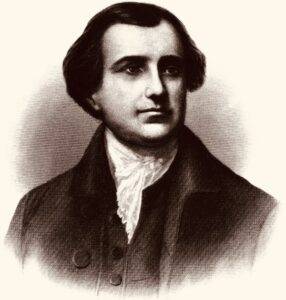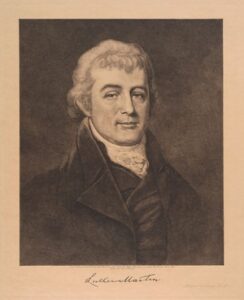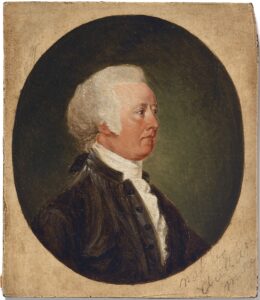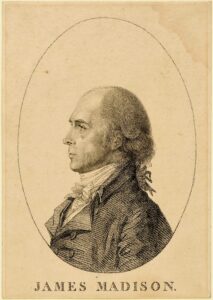A Four-Act Drama
An overview of our Four-Act Drama, a Constitutional Convention role-playing scheme for educators.
Act I: The Alternative Plans

In Act One of the Convention, Governor Randolph introduces the fifteen-point Virginia Plan at the end of May to “revise the Articles of Confederation.” The decisive features of this plan are 1) the complete structural exclusion of the states in terms of both election and representation; 2) the complete diminution of the powers of the states and the virtual freedom of Congress to act in those areas for which the states are incompetent; 3) the establishment of an extended national republic with institutional separation of powers and the introduction of the possibility that short terms of office and term limits—standard features of traditional republicanism—will be abandoned.
Under the wholly federal Articles of Confederation, only the states are represented and the central government is restrained to the exercise of expressly delegated powers. And under the state republican constitutions, the governor has very little authority, and the elected representatives are kept under close scrutiny. Madison’s Virginia Plan introduces a new understanding of federalism and republicanism. This wholly national republican plan is debated, and amended, over the next two weeks, and the main features are adopted by the delegates in mid-June, in preference to two alternatives: the wholly federal, or state-based, New Jersey Plan, that argues that the Virginia Plan goes too far, and the Hamilton Plan that claims the Virginia Plan does not go far enough. Hamilton, among other things, envisioned a President for life.
Act II: The Connecticut Compromise

Act Two portrays the Convention in crisis, in the sense that the delegates are at a stalemate. Far from the wholly national republican Virginia Plan being accepted, as we might very well anticipate when the curtain falls at the end of Act One, the delegates from Connecticut, New Jersey, Delaware, New York, along with Mr. Martin from Maryland—the defenders of the New Jersey Plan, the old style federalism of the Articles, and the old fashioned republicanism of the state constitutions—now insist on questioning the validity of the Virginia Plan. They argue that the Convention has exceeded the Congressional mandate because the Articles have in fact been scrapped rather than revised. Thus the Convention has violated the rule of law. Moreover, the Convention is about to propose a novelty—a large country under one republican form of government—that will never be accepted by the electorate. These delegates, knowing their Locke and Montesquieu and relying on their own political experience, which is remarkably extensive, think republican government can only exist in areas of small extent where the people keep close watch over their representatives.
A breakthrough occurs at the end of June when Oliver Ellsworth of Connecticut suggests that we are neither wholly national nor wholly federal but a mixture of both. Several delegates echo this theme and the Convention decides to move beyond the exclusively national or federal paradigms. The Gerry Committee is created to explore the ramifications of the suggestion that the people be represented in the House and the states be represented in the Senate. This recommendation—the Connecticut Compromise—is accepted over Madison’s objections in mid-July.
Intermission: Committee of Detail at Work
Act III: The Committee of Detail Report

Act Three focuses on the debates during August over the Committee of Detail Report, especially concerning the itemization of Congressional powers. With the Connecticut Compromise in place, the delegates turn from the question of structure to the question of national and state powers. Under the Virginia Plan, Congress was empowered to do anything the States were incompetent to do. By July, that is no longer acceptable to the delegates. A Committee—the Committee of Detail—is created to draft a Constitution that will address the division of powers between the central and state governments and also the separation of powers between Congress, the President, and the Supreme Court.
Another issue that emerges in Act Three is the slavery question. What can Congress do and not do to regulate and/or abolish slavery? This is a vital question and deserves special coverage. It is instructive to compare the clause in the Committee of Detail Report of August 6 with the Signed Constitution of September 17. The former forbids Congress from ever regulating the slave trade and prohibits Congress from discouraging the trade by means of a tax or tariff. By contrast, the final Constitution specifies that the prohibition on Congress will expire in 1808 and permits Congress to discourage the slave trade. In keeping with these revisions, in March, 1807, President Jefferson will sign into law an Act of Congress prohibiting the slave trade effective January 1, 1808, and during the 1790s Congress will take specific steps to discourage the importation of Africans for the purpose of being sold into slavery.
Act IV: The End is in Sight
Act Four covers the final three weeks of the Convention during the month of September. Despite all the progress that has been made on the structural role of the states and enumerating the powers of Congress, there is much work still to be done on the Presidency. The Brearley Committee comes up with the idea of an Electoral College as a sensible compromise to the long and largely fruitless debates on how to elect the President. It has been clear for four months that until the mode of election was settled, no progress can be made on 1) length of term, 2) the issue of re-eligibility, and 3) the powers of the President. The Electoral College is modeled on the Connecticut Compromise: the President will be elected by a combination of people and states.

The Committee of Style writes the final draft of the Constitution. It includes a Preamble and an obligation of contracts clause, both written by Gouverneur Morris, and an enumeration of the powers of Congress in Article I, Section 8. During the last week of the Convention the delegates add a few refinements, raise some serious concerns, and discuss what they agreed to over the four months of deliberations. Mason expresses the wish that “the plan had been prefaced by a Bill of Rights.” Elbridge Gerry supports Mason’s unsuccessful attempt to attach a Bill of Rights. Randolph joins Mason and Gerry, declaring that he too won’t sign the Constitution. And the delegates wonder whether or not the power to create a national university is implied within the meaning of the necessary and proper clause.
On the last day of the Convention, September 17, Benjamin Franklin looks at the chair occupied by Washington and the sun enshrined on its back. Over the four months of deliberation, frustrated delegates often worried that it was a setting sun. Franklin now assures the delegates that it is a rising sun.
